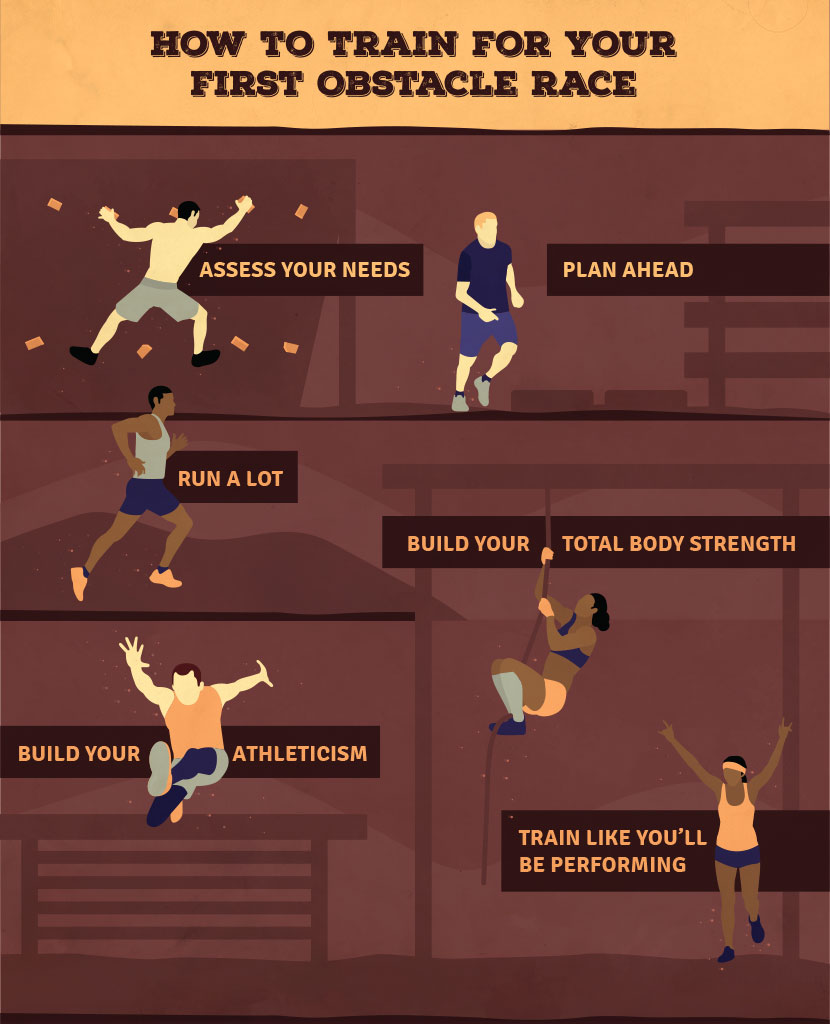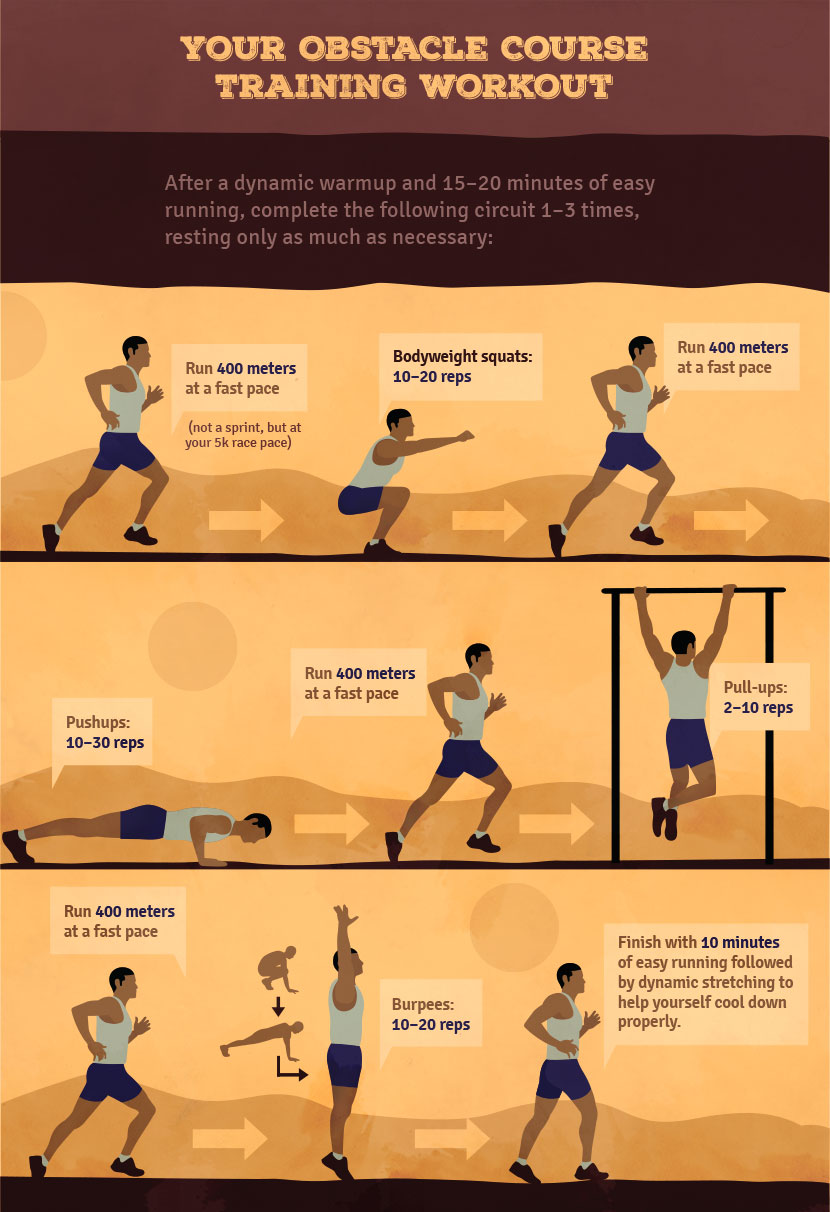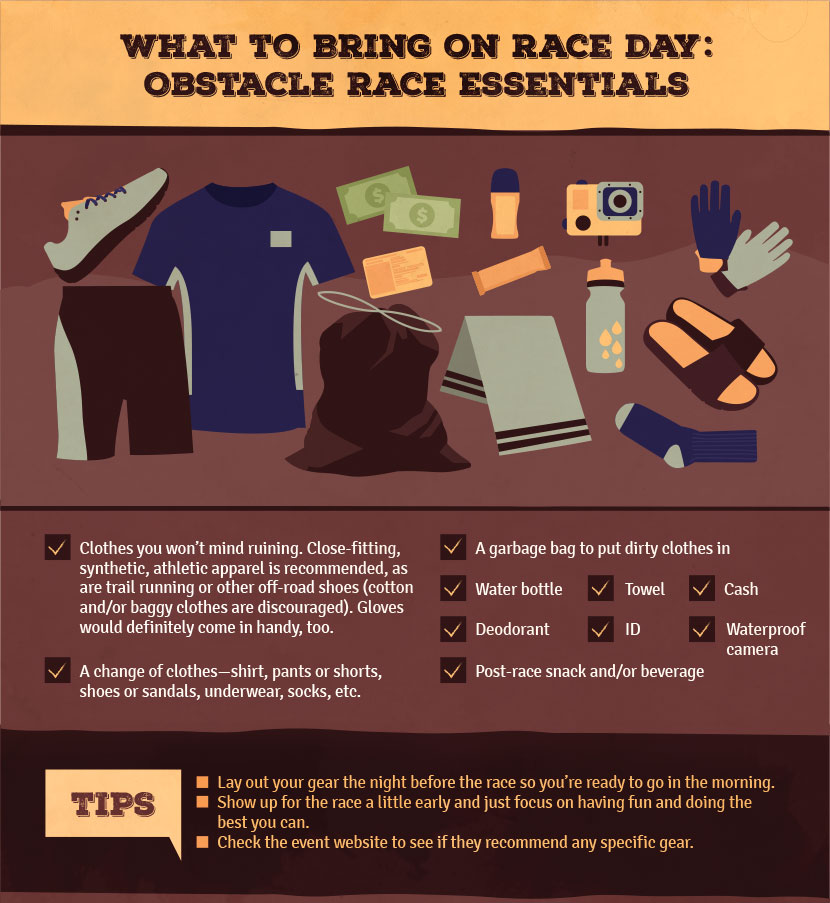Looking for an exciting and tough physical challenge? Does getting covered in mud from head to toe sound like a good time? You may be ready to sign up for your first obstacle race. Whether it’s a Tough Mudder, Warrior Dash, Spartan Race, or some other obstacle race or mud run, be warned: these are not your typical road races. Obstacle races require a unique approach both in training and racing.
For a successful race, it’s crucial to prepare well before reaching the starting line. And crossing the finish line with a smile is no easy feat. Fortunately, there are many strategies to improve the odds of a great race. This guide will cover all the basics.
5 Things You Can Expect From Your First Obstacle Race
Most obstacle races have an element of uncertainty. Race organizers usually plan some surprises and change elements of the course from race to race. Expect the unexpected and be willing to adapt. Even so, there are some aspects of obstacle races that are (almost) guaranteed.
1. You’re Going to Get Very Dirty
Imagine sweating profusely and then having mud (and who knows what else) all over you. Chances are you’ll crawl through mud pits, stumble into ponds, and jump in and through streams. Bonus: You’ll accomplish this with hundreds of other sweaty people.
If you’re a clean freak, bring some toiletries for easier post-race cleanup. Plan to take a nice long shower once you finally get home (you may find mud in places you never anticipated).
2. You Will be Tested Physically and Mentally
All races are hard, but an obstacle race will present some unique challenges. Contestants are pushed to the edge with new kinds of discomfort that aren’t typical in road races, such as:
- The water will probably be very cold
- You’ll be filthy
- You may get some bumps, bruises, cuts, and scrapes
- Your body may freak out with the constantly varying activities (for example speeding up, slowing down, climbing, crawling, jumping, etc.)
- You may even get caught on barbed wire or risk electrocution at some races
- Not to mention that you’ll cover a long distance and traverse tough obstacles as fast as possible, just as in any other race
There may be a point during your race when you want to quit, and you’ll have all kinds of rational reasons to throw in the towel. You’ll seriously question your sanity and wonder why on Earth you’re subjecting yourself to this – for fun. If you expect those doubts, then you’ll be ready when they arise. You’ll remember why you signed up and how you’d feel if you quit.
3. You’ll be in Good Company
Obstacle races are highly social events – even more so than typical road races. You’ll develop a sense of camaraderie with your fellow muddy racers as you go through this trial by fire together. Teamwork comes into play as well, and may come in handy for some of the toughest obstacles. Don’t expect to be a lone wolf.
If this is your first race, finding a team is a wise strategy. Instead of worrying about how hard it will be for you, think about how you can help your teammates and have fun together.
4. You Will Either Have the Time of Your Life or You’ll be Completely Miserable (and it’s Mostly up to You)
It’s true that obstacle races are modeled on military boot camp “O-courses,” but the recreational versions are a lot of fun. While races can certainly be very physically challenging events, how hard they are for you will largely depend on your attitude. Accept that it’ll be tough and get comfortable with being uncomfortable.
5. When you Cross the Finish Line, You’ll be Hooked
You will be proud of yourself and happy you went the distance. You’ll also probably talk about it for days to come. Sure enough, you may find yourself signing up for the next obstacle race.
How to Train for an Obstacle Race
Obstacle races present a complex physical challenge because there are many different activities in one race. You don’t need to be a super athlete, but being a well-rounded athlete will absolutely help performance and will largely determine how much fun you have.
For example, if a person has poor endurance and has to gasp for breath the entire time, they may not have so much fun. But with proper planning and preparation, you can actually enjoy the race instead of merely surviving it. Make it a point to diversify your training and focus on a few key areas, such as endurance, strength, and athleticism, to be well prepared for whatever is in store at your first race.
Focus on the following for your first obstacle race:
1. Assess your Needs
Before you get started, assess both your starting point and end goal. Ask yourself these questions:
- What kind of obstacle race are you planning to complete? Is it a short race or a long one?
- Can you already run the distance? How easily?
- Are you in good shape or just getting back into it?
- Do you have decent upper body strength?
- How would you rate your overall agility and your ability to traverse obstacles?
Try to identify your strengths and weaknesses and then compare them to the requirements of your upcoming event to train accordingly.
2. Plan Ahead
If you’re an active runner, athlete, or fitness trainee, then give yourself at least 6 to 8 weeks to prepare for an obstacle race. If you’re new to running or fitness, you may want to devote 12 to 16 weeks.
3. Run a Lot
This is arguably the most important conditioning variable. Regardless of your specific event, make sure you allow plenty of time to build endurance with long runs and high weekly mileage. If your event is about three miles long, make sure that you can easily cover the distance. It will be enormously helpful to build your long run to at least six miles. Of course, be smart and don’t rush the process. Build your mileage gradually. But run. There’s a reason the best obstacle racers are runners.
4. Build Your Total Body Strength
You’ll be able to navigate the obstacles much more easily if you’ve got a decent foundation of strength. You don’t need to be a strongman, but being able to complete some bodyweight exercises with relative ease will help you immensely.
At a minimum, work up to doing at least a few pull-ups, 30 pushups, 30 to 50 bodyweight squats, and being able to hold an elbow plank for one minute or longer. This general strength will help you pull yourself over walls, climb the monkey bars, run up steep hills, and leap over obstacles. Basic weightlifting exercises, including squats, deadlifts, and weighted carries, would definitely be helpful, too. A comprehensive strength program is not necessary.
5. Build Your Athleticism
A solid foundation of strength and endurance is a great start and will put you above most of the other racers. Completing some drills to enhance agility, coordination, and overall athleticism will give you a big edge.
Consider mobility drills, dynamic stretches, and flexibility exercises to make sure you have a full range of motion in all of your joints. Incorporate some jumping and crawling practice into some of your training, whether it’s during runs or strength workouts. It’s ideal to find a place to practice climbing, such as a local playground.
6. Train the Same Way You’ll be Performing
This is where you put it all together into a more race-specific training program. The closer you can model the training to the physical demands of the actual event, the more prepared you’ll be for the race.
Consider implementing these ideas into your program.
- Do as much running on trails as possible, to simulate the terrain of an obstacle race (which will include mud, rocks, roots, hills, etc.)
- Run hills, which will build endurance and strength (Note: some obstacle races are at ski resorts and are labeled “mountainous.”)
- Run a cross-country race, which will likely include both trails and hills
- Do some intense workouts that will require you to change gears and run at different speeds (for example, Fartlek workouts)
- Find a local parkour group and take a class to practice challenging movements
When you get to the starting line you will know if you’re prepared or not. That knowledge is going to set the tone for the entire race. Do everything you can to succeed before the race in order to have a greatly increased race day confidence level.
Sample Workout for Obstacle Course Training
Keep in mind: This is not a comprehensive training plan, but a good workout template with a broad spectrum of fitness and conditioning benefits. Incorporate this workout into your pre-race routine to get into obstacle shape.
Workout Notes:
1. Adjust the distance of the runs based on your conditioning level and the length of your race.
2. Feel free to substitute other exercises into the strength-training portion. Some other great exercises are:
- Walking lunges
- Front and/or side planks
- Squat jumps (or box jumps)
- Mountain climbers
- Push presses
- Bodyweight rows
- Farmer walks or other weighted carries (for example, shoulder carry)
- Crawling (on hands and knees, hands and feet, or army crawling)
If you complete three circuits total, then you could select one variation of each exercise (for 12 exercises total), which will create a workout that’s well rounded.
3. This workout can be completed once or twice a week. Start with one session weekly and gradually work your way up to two sessions.
4. Increase the difficulty of the workout in three ways:
- Do more circuits per workout (work up to three circuits total before implementing the next two ideas)
- Increase the number of reps you perform for each exercise
- Increase the speed of your runs
Regardless of how many circuits you complete, pace yourself to reach your peak gradually for the final portion of your workout. Think of your pacing strategy in three distinct phases:
- Phase 1 (the first third of the workout) Keep your level of effort between easy and moderate. Focus on technique and save energy for later.
- Phase 2 (the middle third of the workout) Gradually build the level of intensity during each round. Settle into a moderate pace (nowhere near your maximum)
- Phase 3 (final third of the workout) Increase your effort level to 80 to 90 percent of your maximum, but without compromising your form. Think of this as a strenuous, but not maximum-level, pace.
5 Tips for Success On Race Day
Race day will be stressful – there’s no way around that. Use these suggestions for the best experience possible:
1. Relax
No doubt you’ll be a little anxious prior to your first obstacle race. That’s normal. Everyone gets anxious, so just hang out with your friends or some of the other competitors.
Then focus on your breathing. Take some deep breaths and remind yourself you can do this because you’re well prepared. Trust the training you’ve done. Once you get moving, you’ll be fine.
2. Warm up Properly
Warm up just like you would before any other race. A few moments after the gun sounds, you may be sprinting, then totally submerged in very cold water, and then have to climb up a steep hill – all of which will place many different demands on your body. The last thing you want is a pulled muscle, a strain, or worse.
If you want to feel and perform at your best, then you’ll want to be thoroughly warmed up. Do some easy running, a couple stride repeats, some dynamic stretches, and perhaps a few targeted flexibility drills based on your needs. Make sure you’re loose, sweating lightly, and warm when the gun goes off (even if other competitors are just standing around).
3. Be in the Right Place at the Right Time
If you’re planning to compete with the best of them, then make your way to the front of the pack before the race starts. When the race starts, try to stay up front during the initial rush so you don’t have to pass too many people or wait in line behind an obstacle. On the other hand, if you’re not in it to win it, then start in the middle or rear of the pack and let the elite athletes do their thing.
4. Don’t do Anything Unsafe
There are risks involved in every obstacle race. That’s why they insist on you signing a waiver. If at any point you’re not sure of yourself, slow down and be careful. Take a short break if needed, or ask for a hand or leg up. If an obstacle looks too challenging for you – or if it just doesn’t feel right – then simply go around it.
5. Have Fun
That’s why you’re doing this after all, right? So, smile! Laugh! And be sure to make fun of your friends when they get clumps of mud stuck to their face and can’t see where they’re going.
Go Forth and Dominate
Obstacle racing is a unique and fun way to spend a weekend morning (and earn some major bragging rights). With the right planning, preparation, and some realistic expectations for race day, you’ll set yourself up for a great first race.
If you’re still hesitant, keep in mind that plenty of people who complete these races aren’t tough super-athletes. If you’re reasonably fit and healthy enough to exercise, then you can probably complete an obstacle race without too much trouble.
Follow the guidelines in this article to prepare and you may just surprise yourself with your accomplishments on race day. Once you’ve crossed the finish line, you’ll understand that while it wasn’t easy, it was absolutely worth it.
Always hope for the best, prepare for the worst, and expect the unexpected. Now, go forth and dominate your first obstacle race!
Reposted with permission from Fix.com






Chaitra on
#639, C class. Just a reminder it is not her. Sammi Powell is #355, B class, and she did NOT race last night. Will the real 639 plsaee stand up! Is it possible to get the spreadsheet for lap times in the A race? Having a blast.
Shuuma on
Next time I’m in the US I’ll pick up a couple then.I remebmer at Sea Otter on the long fireroad climb back to the start bunches of people screaming and the cow bells ringing – was a great push up the hill 🙂